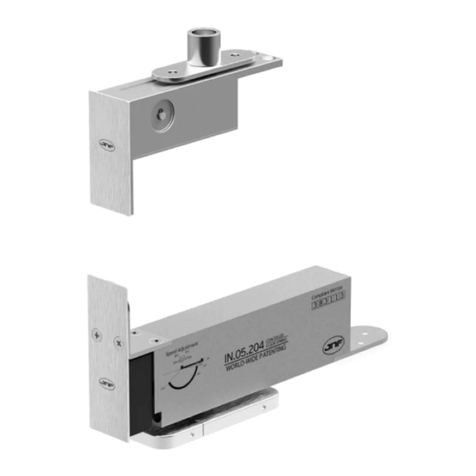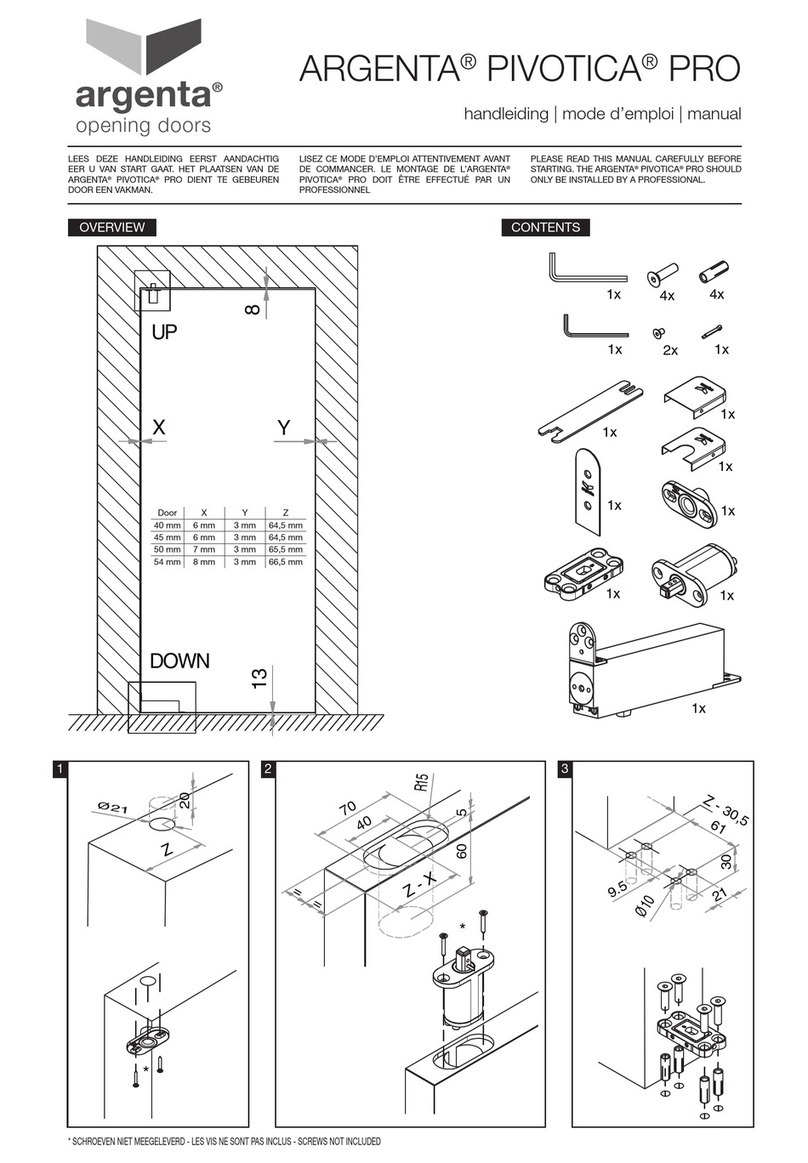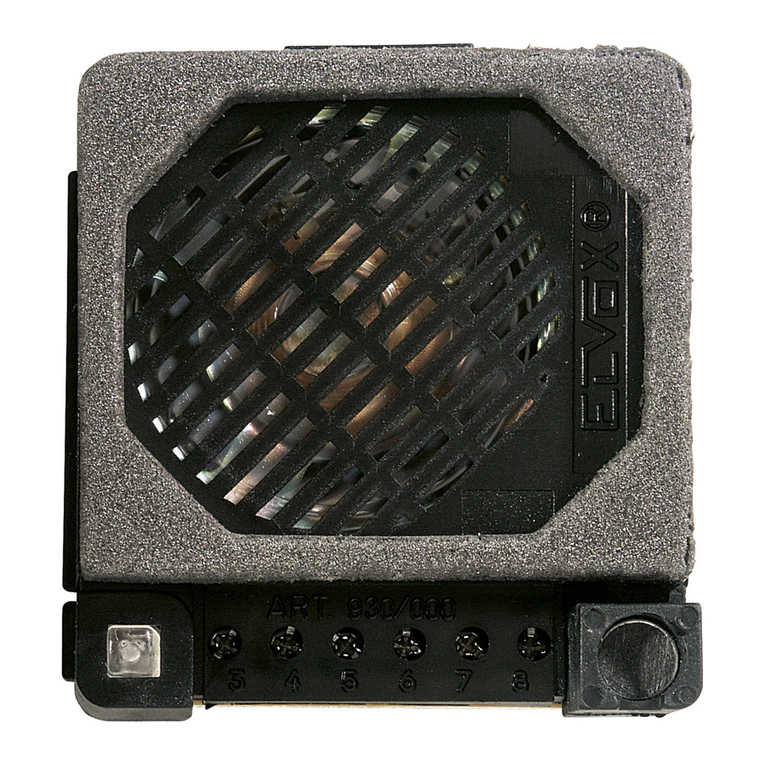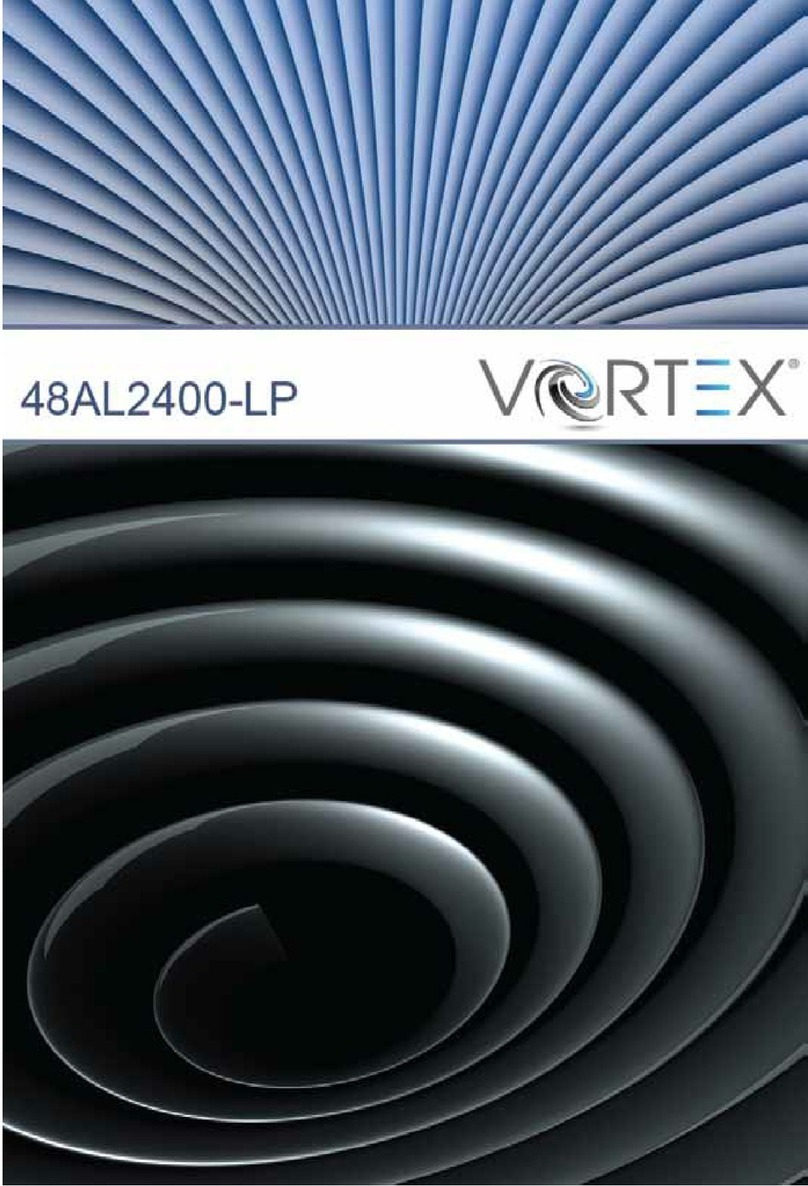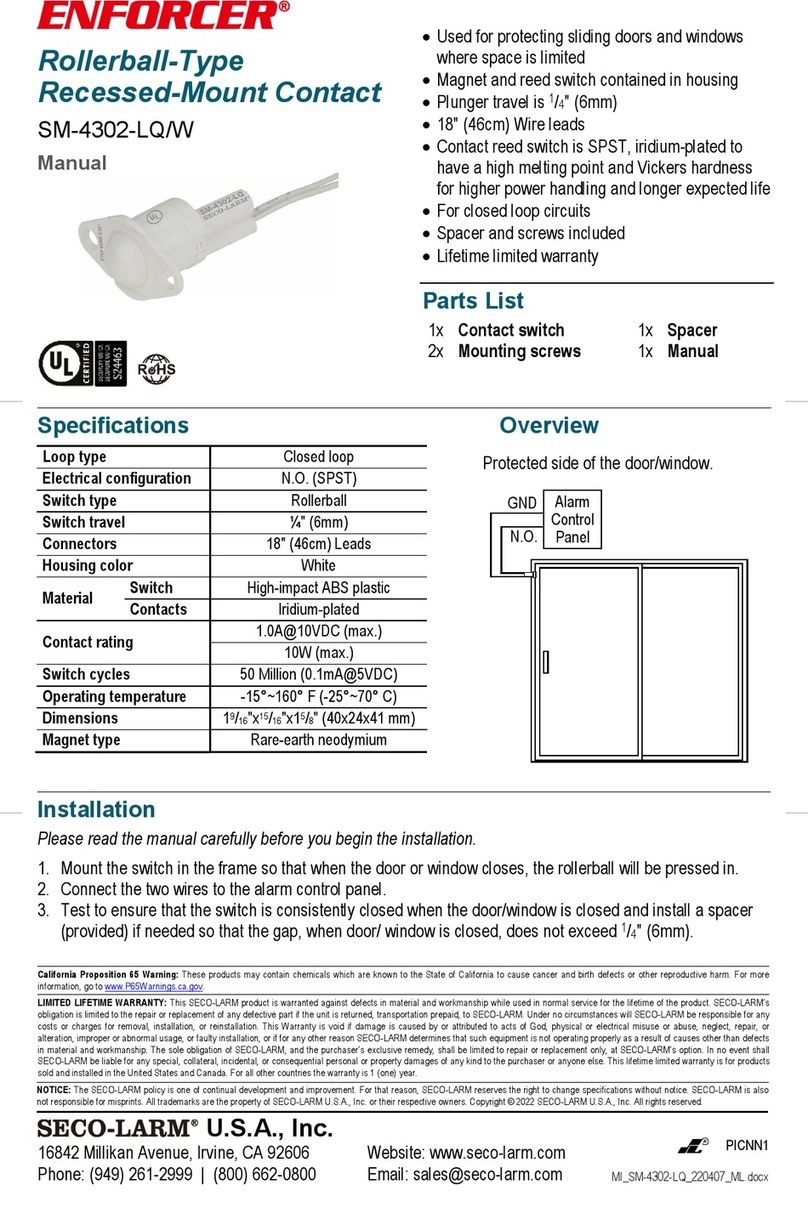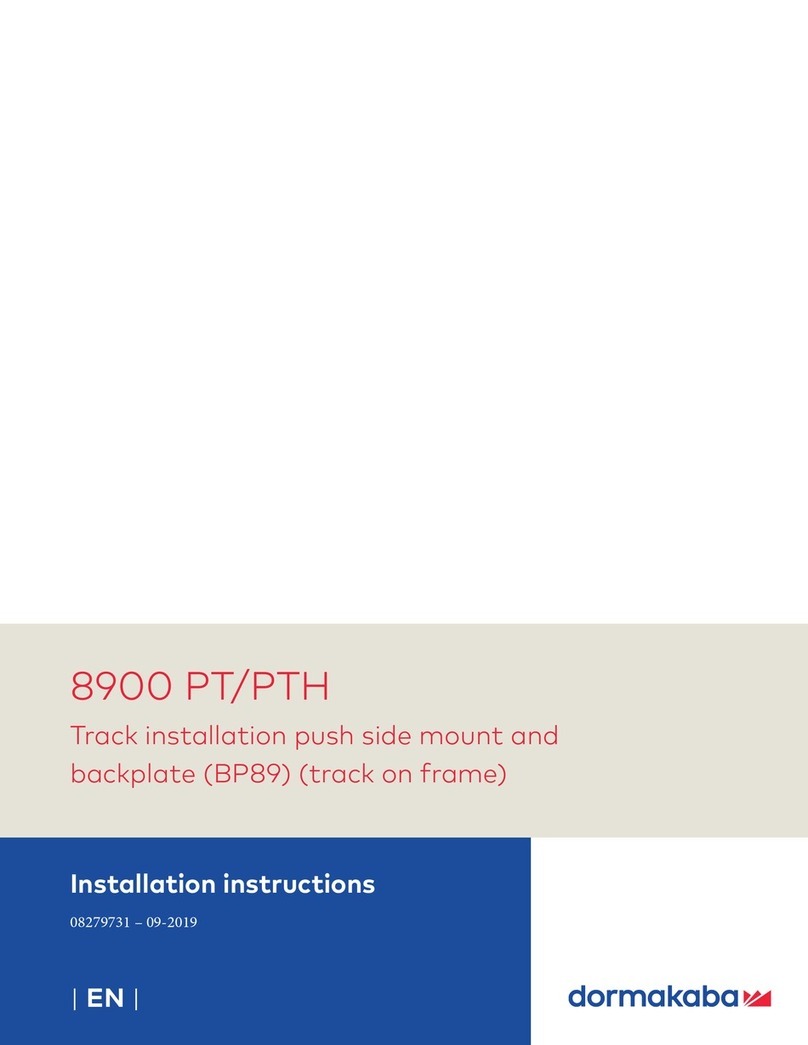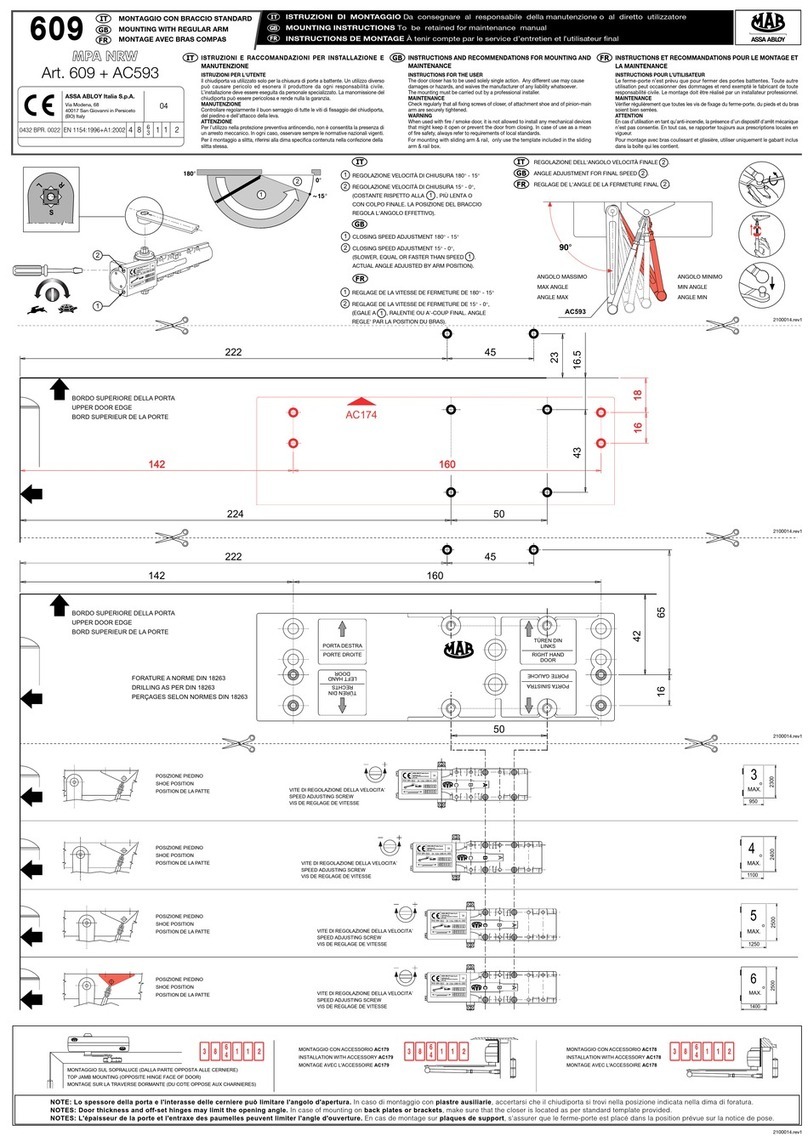MFZ Ovitor CS 110 User manual

Operating Instructions for CS 110 Door Controls EN
CS 110 Door Controls / Rev. A 05 – 1

2 – CS 110 Door Controls / Rev. A 05
1. Contents
1. Contents 2
2. Information in this document 2
3. General safety instructions 3
4. Product overview 4
5. Initial operation 6
6. Initialisation 11
7. Changing the direction of rotation 11
8. Setting the travel limits 11
9. Programming using the LCD Monitor 13
10. Navigator (only with the LCD monitor) 14
11. Input mode (LCD monitor) 15
12. Error indication and elimination 16
13. Door cycle counter 17
14. Technical data 17
15. EC Declaration of Incorporation 18
Original Operating Instructions
−Protected by copyright.
−No part of this manual may be reproduced without our
prior approval.
−Subject to alterations in the interest of technical progress.
−All dimensions are given in millimetres.
−The illustrations are not true to scale.
Meaning of symbols
DANGER!
Safety notice indicating a danger that will directly result in
death or severe injury.
WARNING!
Safety notice indicating a danger that can result in death or
severe injury.
CAUTION!
Safety notice indicating a danger that can result in slight or
moderate injuries.
NOTICE
Safety notice indicating a danger that can result in damage
to property or in irreparable damage to the product
CHECK
Reference to a check that needs to be carried out
REFERENCE
Reference to separate documents that must be observed
Instruction requiring action
−List, itemisation
ÔReference to other sections of this document
2. Information in this document

EN
CS 110 Door Controls / Rev. A 05 – 3
3. General safety instructions
DANGER!
Failure to comply with the documentation could
result in life-threatening danger!
Be sure to follow all the safety instructions in this docu-
ment.
Warranty
The warranty with regard to function and safety is only valid
if the warnings and safety instructions in these operating
instructions are observed.
MFZ Antriebe GmbH + Co. KG accepts no liability for personal
injury or material damage arising from failure to observe the
warnings and safety instructions.
MFZ shall not provide a warranty and does not accept any
liability for damage arising from the use of non-approved
replacement parts or accessories.
Use for the intended purpose
The CS 110 control unit is intended exclusively for the
purpose of controlling door systems that have mechanical or
electronic (AVE) travel limit systems.
Keep remote control units out of the reach of children and
do not allow children to play with xed regulating or control
devices.
Target group
Only qualied and trained specialist tters are allowed to
install the door operator and carry out mechanical servicing
work.
Qualied and trained specialist tters must have the follow-
ing:
− - Knowledge of the general and specic safety and
accident-prevention regulations
−- Knowledge of all the relevant regulations
−Training in the use and care of appropriate safety equip-
ment
−The ability to recognise the risks associated with the instal-
lation work
Only qualied and trained electricians are allowed to connect
up the door operator to the power supply and to carry out
electrical servicing work.
Qualied and trained electricians must have the following:
− Knowledge of the general and specic safety and accident-
prevention regulations
−Knowledge of the relevant electrotechnical regulations
−Training in the use and care of appropriate safety equip-
ment
−The ability to recognise the risks associated with electricity
Instructions relating to installation and connection
−Before commencing electrical works, the system must be
disconnected from the power supply. Measures must be
taken to ensure that the power supply remains switched off
for the duration of the works.
−The local safety regulations must be observed.
−Power cables must be laid separately from control cables.
Regulations and test specications
The following regulations must be complied with when
connecting, programming or servicing the unit. (The list is not
exhaustive.)
Construction product standards
− EN 13241-1 (Products without re resistance or smoke
control characteristics)
−EN 12445 (Safety in use of power operated doors - Test
methods)
−EN 12453 (Safety in use of power operated doors - Requi-
rements)
−– EN 12635 (Garage doors and gates - Installation and
use)
−EN 12978 (Safety devices for power operated doors and
gates - Requirements and test methods)

4 – CS 110 Door Controls / Rev. A 05
EMC
−EN 55014-1 (Electromagnetic compatibility - Requirements
for household appliances)
−EN 61000-3-2 (Limits for harmonic current emissions)
− EN 61000-3-3 (Limitation of voltage changes, voltage uc-
tuations and icker in public low-voltage supply systems)
−EN 61000-6-2 (Electromagnetic compatibility (EMC) - Part
6-2: Generic standards - Immunity for industrial environ-
ments)
−EN 61000-6-3 (Electromagnetic compatibility (EMC) - Part
6-3: Generic standards - Emission standard for residential,
commercial and light-industrial environments)
Machinery standards
−EN 60204-1 (Safety of machinery - Electrical equipment of
machines, Part 1: General requirements)
−EN 12100-1 (Safety of machinery - Basic concepts, general
principles for design, Part 1: Basic terminology, methodo-
logy)
Low-voltage electricity
−EN 60335-1 (Household and similar electrical appliances -
Safety)
−EN 60335-2-103 (Particular requirements for drives for
gates, doors and windows)
Committee for Workplaces (Ausschuss für Arbeitsstätten -
ASTA)
−ASR A1.7 (Technical Regulations for workplaces - Doors
and gates)
4. Product overview
4.1 Models available
The following models of the CS 110 control unit can be
supplied:
−CS 110 control unit integrated in the operator
−CS 110 control unit in CS Mini housing
−CS 110 control unit in CS Standard housing -
All of these models can be tted with a plug-in radio receiver.
The following housing models can be supplied:
−Housing unit with 3-button input unit CS
−Housing unit with 3-button input unit KDT
−Housing with ON/OFF key switch
−Housing with mains switch
−Housing with emergency stop button
The operating instructions describe the connection options
and programming procedures for the following models:
−CS 110 control unit with CSI buttons
−CS 110 control unit with LCD display board CS 250 / 110
General safety instructions

EN
CS 110 Door Controls / Rev. A 05 – 5
4.2 Main circuit board of the CS 110
L1
F1 = 250 mA
400V
230V
PE
- + P
F1
X16X15
X21
X18 X19
X17
X14
X1
X2
L2 L3 L1
U V WX2
X3
X13
K1
X11
X10
X9X8X7X6
X5X4
K3
X12
Key:
PE: Protective earth terminal block
X1: Mains power supply terminal
block
X2: Motor terminal block
X3: Network selection terminal block
X5: Relay terminal block
X8: Emergency stop terminal block
X9: 3-button input unit terminal
block
X11: Mechanical limit switch terminal
block
X12: Connector for RS485 devices
X14: Operating mode terminal block
X15/X16: Circuit card terminal block
X17: Radio terminal block
X18: Terminal block for buttons on
housing
X19: Terminal block for additional
shut-off system
X21: AVE RS485
K1: Relay
K3: Reversing contactor
F1: 250 mA fuse

6 – CS 110 Door Controls / Rev. A 05
5.1 General
WARNING!
To ensure that the system functions properly, the following
conditions must apply:
−The door is installed and functions properly.
−The MFZ geared motor is installed and ready for opera-
tion.
−The command and safety devices are installed and
function properly.
−The control unit housing with the CS 110 control unit is
installed.
NOTICE
The door, the MFZ geared motor and the command and
safety devices must be installed in accordance with the
relevant manufacturer’s instructions.
WARNING!
To ensure that the control unit functions properly, the
following conditions must apply:
−The supply voltage must correspond to the voltage
shown on the type plate.
−The supply voltage must correspond to the voltage of the
door operator.
−With a three-phase current supply, a clockwise rotating
eld must be ensured.
−If a permanent connection is to be made, an all-pole
mains switch must be installed.
−With a three-phase current supply, only three-pole circuit
breakers (10 A) may be used.
WARNING!
Before switching on the control unit for the rst time,
check to ensure that the cabling works are complete and
that all the motor connections are secure at both the
motor and the control unit. All control voltage inputs are
separated galvanically from the mains power supply.
5. Initial operation
5.2 Connection to the mains power supply
Detailed circuit diagram showing mains power connec-
tion (400 V / 230 V / 3-phase)
X3
230 V
X3
400 V
L3
L2
L1
400V 3~/PE
230V 3~/PE
PE
PE
PE
X1
Detailed circuit diagram showing mains power con-
nection (230 V / 1-phase)
L2
L3
L1
230V 1~/N/PE
PE
PE
PE
X1
X3
230 V
L
N
NOTICE
If the bridge is placed in the wrong position at X3, perma-
nent damage to the controls may be caused!
REFERENCE
See page 17 for technical data.

EN
CS 110 Door Controls / Rev. A 05 – 7
NOTICE
Changing the direction of rotation:
After the door operator has been connected, press the
OPEN and CLOSE buttons to check that the direction of
rotation is correct.
If the movement of the door does not correspond to the
buttons pressed, the connections at terminals U and V (or
OPEN/CLOSE) must be swapped over.
NOTICE
Safety switches of the door operator:
If the AVE Standard electronic limit switch is used, the
safety switches of the operator will be connected via the
AVE connector, which means that a bridge must be inserted
at X2:1/2.
5.3 Connection of the door operator
3-phase operator
1-phase operator
M
PE
PE
U
V
W
1
2
ab
a = Thermo switch
b = Emergency release / emergency hand chain /
emergency hand crank
X2
M
PE
PE
N
OPEN
CLOSE
1
2
ab
X2
a = Thermo switch
b = Emergency release / emergency hand chain /
emergency hand crank

8 – CS 110 Door Controls / Rev. A 05
Initial operation
5.4 Connection of limit switches
NOTICE
The limit switch settings are programmed automatically
during initial operation.
The type of limit switch used can be entered in the Input
menu.
a) Mechanical limit switches
X11
1 = Limit switch,
OPEN
2 = Limit switch,
CLOSE
3 = Pre-limit switch,
CLOSE
b) Electronic limit switch RS485
CS 110 in housing
X21
The numbers on the connector are
also the numbers of the leads:
4: Safety circuit input
5: RS 485 B
6: GROUND
7: RS 485 A
8: Safety circuit output
9: 12VDC
NOTICE
If no limit switch is connected at RS885, then the
safety circuit (4/8) must be bridged.
c) Electronic limit switches
CS 110 control unit integrated in the operator
X22 (on the plug-in circuit board)
The numbers on the connector are
also the numbers of the leads:
1: 5VDC
2: Signal 1
3: Signal 2
4: GROUND
5.5 Connection of safety devices
X8
1: Emergency stop
or door safety circuit
NOTICE
If no emergency stop is connected, the input must be
bridged.

EN
CS 110 Door Controls / Rev. A 05 – 9
3-button input unit - external button (KDT)
X9
External key switch
X9
NOTICE
If no stop system is connected at X9, then the input must be
bridged.
5.7 Connection for relay output
X5
STOP
OPEN
CLOSE
STOP
OPEN
CLOSE
5.6 Connection of command devices
CSI 3-button input unit
X12
4: Safety circuit input
5: RS 485 B
6: GROUND
7: RS 485 A
8: Safety circuit output
9: 12VDC
NOTICE
If no CSI button input unit is connected, then the
safety circuit (4/8) must be bridged.
CS 3-button input unit
X18
STOP
OPEN
CLOSE

10 – CS 110 Door Controls / Rev. A 05
Initial operation
5.8 Plug-in module
X15
X16
LED 1
LED 2
X15 X16
X22
LED 2 LED 1
NOTICE
Operation is not possible without the plug-in module.
5.9 Operating mode selector switch
X14
J1 Mode of operation for closing
direction:
Open: deadman mode
Closed: press-and-release
J2 Mode of operation for opening
direction:
Open: deadman mode
Closed: press-and-release
NOTICE
Operation with the press-and-release mode is allowed only
if the safety devices required by the regulations are in place.
5.10 Options
5.10.1 Radio receiver - CS plug-in radio system
X17
Program the transmission code:
1. Give the programming button of the receiver a short
press (holding for less than 1.6 seconds). The
programming mode will be activated. The LED of the
receiver ashes.
2. Press the channel button of your transmitter. When
the radio control system has saved the transmission
code, the LED of the receiver will light up and remain
lit for approximately 4 seconds.
5.10.2 Module - additional shut-off system
X19

EN
CS 110 Door Controls / Rev. A 05 – 11
6. Initialisation
During initial operation (when the power supply is switched
on), the controls automatically program the following compo-
nents:
−Limit switch system
−CSI buttons
−Display
During the automatic programming process, the red LED
on the CPU board lights up. Operation of the system is not
possible.
NOTICE
Before initialising the system:
The components must be installed before initial operation.
If these components are altered or added at a later date,
they can be automatically programmed via the CS compact
display or by initialising the system again.
Initialisation mode: The control unit can be switched to ini-
tialisation mode by pressing the “-” and “P” buttons on the
circuit board at the same time and keeping them pressed as
you switch on the power. Keep the buttons pressed until the
green LED lights up.
The saved travel limit settings will then be deleted and all
the parameters will be reset to the factory settings.
NOTICE
7. Changing the direction of rotation
During initial operation, the directional rotation of the door
operator must be checked and, if necessary, changed.
Switch to adjustment mode.
Press the OPEN button (if possible) The door should move
in the open direction. If the door moves in the close direc-
tion, you must change the direction of rotation.
Continue by setting the travel limits.
NOTICE
Changing the direction of rotation
Switch to adjustment mode.
Press the + and - buttons on the circuit board at the same
time and hold pressed for 5 seconds.
The red LED will ash rapidly.
Alternatively, two of the phases of the door operator can be
swapped with each other.
8. Setting the travel limits
8.1 Setting the electronic travel limits using
the adjusting buttons on the circuit board
Switch to ADJUSTMENT mode by pressing the P button and
holding for approximately 5 seconds. The red LED will ash
slowly.
Setting the travel limit in the OPEN direction
−Press the OPEN/CLOSE button to drive the door to the
desired travel limit position in the OPEN direction.
−Then save the travel limit position by pressing the P
button and the OPEN button at the same time.
The red LED will ash quickly for approximately 1
second.
Setting the travel limit in the CLOSE direction
−Press the OPEN/CLOSE button to drive the door to the
desired travel limit position in the CLOSE direction.
−Then save the travel limit position by pressing the P
button and the CLOSE button at the same time.
The red LED will ash quickly for approximately 1
second.
The adjustment mode will then end automatically. The red
LED will switch off.
NOTICE
−The adjustment mode will end automatically after 10
seconds if no key is pressed.
− When setting the travel limits for the rst time, both
travel limit positions must be set; otherwise, normal
operation will not be possible.
−If one of the travel limit positions needs to be readjusted,
you can press the “P” button to leave the Adjustment
menu after resetting the travel limit in question.

12 – CS 110 Door Controls / Rev. A 05
Setting the travel limits
8.3 Setting the electronic travel limits using
the LCD display
Switch to ADJUSTMENT mode.
−Press the “P” button until “Adjustment” appears in the
display.
Setting the travel limit in the OPEN direction
−Press the “+” button to drive the door to the desired
travel limit position in the OPEN direction.
−Then save the travel limit position by pressing the “P”
button and the “+” button at the same time.
Setting the travel limit in the CLOSE direction
−Press the “-” button to drive the door to the desired
travel limit position in the CLOSE direction.
−Then save the travel limit position by pressing the “P”
button and the “-” button at the same time.
Press the “P” button to leave adjustment mode.
NOTICE
− When setting the travel limits for the rst time, both
travel limit positions must be set; otherwise, normal
operation will not be possible.
−If one of the travel limit positions needs to be readjusted,
you can press the “Stop” button or “P” button to leave
the Adjustment menu after resetting the travel limit in
question.
8.4 Setting the mechanical travel limits
Switch to ADJUSTMENT mode.
Set the travel limits as described in the instruction manual
supplied with the mechanical limit switches.
Press the “P” button to leave adjustment mode.
NOTICE
−The adjustment mode will not end automatically. In order
to return to normal operating mode, you must leave
adjustment mode by pressing the “P” button.
8.2 Setting the electronic travel limits using
the CSI 3-button input unit
Switch to ADJUSTMENT mode.
−Press the STOP button for approximately 5 seconds. The
red LED will ash rapidly.
−Release the STOP button. The red LED will light up for
2 seconds.
−Press the STOP button within this 2-second period and
hold it pressed for approximately 5 seconds. The red
LED will ash slowly. Release the STOP button.
Setting the travel limit in the OPEN direction
−Press the OPEN/CLOSE button to drive the door to the
desired travel limit position in the OPEN direction.
−Then save the travel limit position by pressing the STOP
button and the OPEN button at the same time.
The red LED will ash quickly for approximately 1
second.
Setting the travel limit in the CLOSE direction
−Press the OPEN/CLOSE button to drive the door to the
desired travel limit position in the CLOSE direction.
−Then save the travel limit position by pressing the STOP
button and the CLOSE button at the same time.
The red LED will ash quickly for approximately 1
second.
The adjustment mode will then end automatically. The red
LED will switch off.
NOTICE
−The adjustment mode will end automatically after 10
seconds if no key is pressed.
− When setting the travel limits for the rst time, both
travel limit positions must be set; otherwise, normal
operation will not be possible.
−If one of the travel limit positions needs to be readjusted,
you can press the “P” button to leave the Adjustment
menu after resetting the travel limit in question.

EN
CS 110 Door Controls / Rev. A 05 – 13
9. Programming using the LCD Monitor
9.1 Overview of the LCD monitor
AUTOMATIC O
RESTING
A
B
C D E
F
G
H
Key:
A: Mode of operation / Diagnostics info
B: Parameters / Diagnostics info
C: (+) button
D: (-) button
E: (P) button
F: Value / Status
G: Value / Status
H: Jumper
9.2 Modes of operation of the LCD monitor
CAUTION!
The mains power supply must be switched off before con-
necting the display unit. Only a display unit manufactured
by MFZ (article number 1700004793) may be used.
In combination with the LCD monitor, the control unit has
four modes of operation:
1. AUTOMATIC
2: ADJUSTMENT
3: INPUT
4: DIAGNOSTICS
If the Jumper H is pulled out, the “+”, “-” and “P” buttons
will have no effect. The display will continue to function.
Operating mode 1: AUTOMATIC
The AUTOMATIC mode is used for operating the door.
Display:
−Displays the action being carried out
−Displays any errors
If the jumper at J1/J2 is used to set the operating mode to
deadman operation, then MANUAL will be shown in the
display instead of AUTOMATIC.
Operating mode 2: ADJUSTMENT
The ADJUSTMENT mode is used for setting the travel limits
for the OPEN and CLOSE directions. Fine adjustments can be
made in the INPUT operating mode.
Display:
−Displays the travel limit value
NOTICE
When in ADJUSTMENT mode, the door will not stop
automatically when it reaches the travel limit position.
Driving the door beyond the travel limit position could cause
damage to the door.
Operating mode 3: INPUT
In the INPUT mode, the values of various parameters can be
altered.
Display:
−Displays the selected parameter
−Displays the current value or status
Operating mode 4: DIAGNOSTICS
In the DIAGNOSTICS mode, door-specic monitoring can be
carried out.
Display:
−Displays the monitored function
−Displays the status of the function

14 – CS 110 Door Controls / Rev. A 05
AUTOMATIC
RESTING
P
> 1 second
ADJUSTMENT
RESTING
+
-> Position, DOOR OPEN ADJUSTMENT
MANUAL OPEN
Save door position:
P
hold and
+
> 1 sec
-
-> Position DOOR CLOSED ADJUSTMENT
MANUAL CLOSE
Save door position:
P
hold and
-
> 1 sec
P
> 1 sec
INPUT
+
and
-
> 2 sec INPUT
DEUTSCH :
Scroll up in menu:
+
> 2 sec
Scroll down in menu:
-
> 2 sec
Select value:
P
> 1 sec
Increase the value:
+
Decrease the value:
-
Save the value:
P
Return to mode: INPUT:
+
and
-
> 1 sec
INPUT
FINE OPEN : 0
INPUT
FINE CLOSE : 0
INPUT
ROT.FIELD : MOD1
INPUT
LIMIT SWITCH : MOD1
INPUT
RELAY 1 : MOD14
DIAGNOSTICS Scroll up in menu:
+
> 2 sec
Scroll down in menu:
-
> 2 sec
Return to mode -AUTOMATIC:
P
Only data requests are possible
TOP ES : ON
BOTTOM ES : OFF
OPEN BUTTON : OFF
CLOSE BUTTON : OFF
STOP CIRCUIT : ON
DOOR CYCLES : 0000
AVE : XXXX
10. Navigator (only with the LCD monitor)

EN
CS 110 Door Controls / Rev. A 05 – 15
Function Description Possible settings Factory settings
Language Select the menu language D, GB, F, NL D
RELAY 1
MOD1: Red warning light ashes as warning before door movement and
lights up during movement
MOD2: Red warning light ashes as warning before door movement and
ashes during movement
MOD3: Red warning light lights up as warning before door movement and
lights up during movement
These 3 modes are affected by the parameter M1-3 RESTING
MOD4: Impulse when OPEN command is given
MOD5: Error message
MOD6: Travel limit in OPEN direction
MOD7: Travel limit in CLOSE direction
MOD8: Travel limit in OPEN direction negated
MOD9: Travel limit in CLOSE direction negated
MOD10: Pre-limit position in OPEN direction
MOD11: Pre-limit position in CLOSE direction
MOD12: Pre-limit position in CLOSE direction to travel limit in CLOSE
direction
MOD13: Magnetic lock function
MOD14: Brake
MOD1 – MOD14 Relay 1: MOD14
FINE
OPEN
Fine adjustment of the travel limit in the OPEN direction, in relation to the
saved travel limit position in the OPEN direction -250 to +250 0
FINE
CLOSE
Fine adjustment of the travel limit in the CLOSE direction, in relation to the
saved travel limit position in the CLOSE direction -250 to +250 0
ROT.FIELD MOD 1: Clockwise rotating drive
MOD 2: Anticlockwise rotating drive MOD1, MOD2 MOD1
LIMIT
SWITCH
MOD 1: AVE
MOD 2: mechanical limit switches MOD1, MOD2 MOD2
NOTICE
The parameters FINE CLOSE, FINE OPEN and ROT.FIELD can be used only in conjunction with the AVE limit switch.
11. Input mode (LCD monitor)

16 – CS 110 Door Controls / Rev. A 05
12. Error indication and elimination
LED 1, green (circuit card or CSI button)
Error Indicator Comments
No operating voltage present Off No voltage supply present
LED 2, red (circuit card or CSI button)
LCD display
Error Indicator Comments
Error STOP 1x ash Stop circuit must be closed; door movement then possible
Error RS485 2x ash System stopped; error in transmission protocol.Acknowledge the error by
pressing Stop; restart is possible by pressing button.
Error Travel Limit 3x ash System stopped and no door movement possible. Disconnect control unit from
power supply; reprogram the travel limit positions.
Error Rotational eld 4x ash System stopped and no door movement possible. Switch the rotational direc-
tion; disconnect control unit from power supply.
Error Power 5x ash System stopped. Acknowledge the error by pressing Stop; restart is possible by
pressing button.
Error Running time 6x ash System stopped. Acknowledge the error by pressing Stop; restart is possible by
pressing button.
NOTICE
After the cause of the error has been remedied, the control unit must be disconnected from the power supply and then recon-
nected.

EN
CS 110 Door Controls / Rev. A 05 – 17
Dimensions of
housing:
165 x 220 x 110 mm
Installation: install vertically on a wall; minimum installation
height: 1,100 mm
Power supply via
L1, L2, L3, N, PE:
400 V 3~, 230 V 3~ or 230V 1~50 / 60Hz;
Power input:
max. 2200 W with 400V 3-phase supply
max. 1500 W with 230V 3-phase supply
max. 1100 W with 230V 1-phase supply
60% duty cycle with a maximum running time
of 120 s
Fuse protection: Type K 8A fuse, to be tted by the customer
on site
Power consumption
of controls alone:
max. 250 mA
Control voltage: 24 V DC; maximum of 250 mA; protected by
a self-resetting fuse for external sensors. All
control voltage inputs are separated galvanically
from the mains power supply.
Control inputs: 24 V DC, all inputs must be connected such that
they are potential-free.
Minimum signal duration for input control
commands > 100 ms
Control outputs: 24 V DC, maximum of 150 mA
Relay outputs If inductive loads are connected (e.g. additional
relays or brakes), these must be equipped with
suitable interference suppression (recovery
diode, varistors, RC circuits).
Normally-open potential-free contact; minimum
of 10 mA; maximum of 230 V AC / 4 A
Once contacts have been used in power circuits
they can no longer be used for low currents.
Safety circuit / Emer-
gency off function:
It is essential that all inputs are connected such
that they are potential free; if the safety circuit
is interrupted, no further door operator move-
ment is possible, not even in deadman mode.
Temperature range: In operation: -10 °C ... +45 °C
In storage: -25 °C ... +70 °C
Air humidity: Up to 80% with no condensation
Vibration: Low-vibration mounting, e.g. on a masonry wall
Protection class IP 65
Weight Approx. 1.8 kg
13. Door cycle counter 14. Technical data
The number of cycles can be shown by pressing the buttons
on the circuit board. The red LED will indicate the number of
cycles by ashing.
−Drive the door to the travel limit in the OPEN direction.
−Press the OPEN button and then the P button immediately
afterwards, keeping both buttons pressed for approximately
5 seconds.
−The number of cycles will then be shown by a series of
ashes E__Z__H__T__ZT__HT
(whereby a zero is indicated by two short ashes).
− The break between digits is indicated by the ashing of the
green LED.
Example: 10408 cycles (* long ash / * short ash)
Green LED *****
Red LED *_*_*_*_*_*_*_* ** *_*_*_* ** * **
Value 8 0 4 0 1 0

18 – CS 110 Door Controls / Rev. A 05
15. EC Declaration of Incorporation
We hereby declare that the following product:
CS 110 Door Controls
complies with the basic requirements of Machinery Directive
(2006/42/EC):
This partly completed machinery complies with all the regula-
tions of the EC Construction Products Directive (89/106/EEC),
EC Electromagnetic Compatibility Directive (2004/108/EEC)
and the EC Low Voltage Directive (2006/95/EC).
The following standards were applied:
EN 60204-1
Safety of machinery - Electrical equipment of machines, Part
1: General requirements
EN 12100-1
Safety of machinery - Basic concepts, general principles for
design, Part 1: Basic terminology, methodology
EN 12453
Safety in use of power operated doors - Requirements
EN 12604
Doors and gates - Mechanical aspects - Requirements
EN 61000-6-2
Electromagnetic compatibility (EMC) - Part 6-2: Generic stan-
dards - Immunity for industrial environments
EN 61000-6-3
Electromagnetic compatibility (EMC) - Part 6-3: Generic
standards - Emission standard for residential, commercial and
light-industrial environments
EN 60335-1
Household and similar electrical appliances - Safety
EN 60335-2-103
Particular requirements for drives for gates, doors and win-
dows
Manufacturer and manager of documentation
MFZ Antriebe GmbH & Co. KG, Neue Mühle 4, 48739 Legden,
Germany
The special technical documents were prepared in accordance
with Annex VII, Part B of EC Machinery Directive 2006/42/
EC. We undertake to supply these documents, in electronic
form and within a reasonable period, in response to a duly
reasoned request from the market surveillance authorities.
The partly completed machine may not be set in operation
until it has been ascertained that the machine in which the
partly completed machine is to be installed complies with all
the requirements of Machinery Directive (2006/42/EC).
Place and date
Legden, den 18 January 2012
Manufacturer’s signature
Hans-Joachim Molterer
Job description of the signatory
Executive Director

EN
CS 110 Door Controls / Rev. A 05 – 19

#1700012038
#103730
Table of contents
Popular Door Opening System manuals by other brands
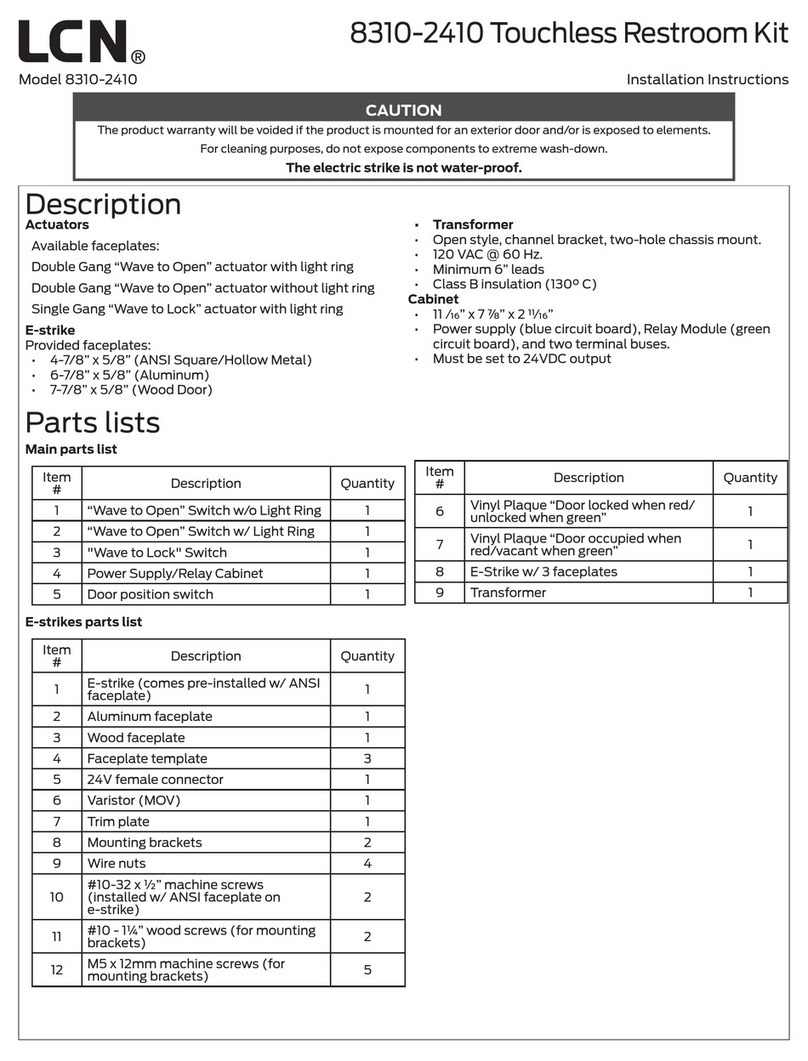
LCN
LCN 8310-2410 installation instructions
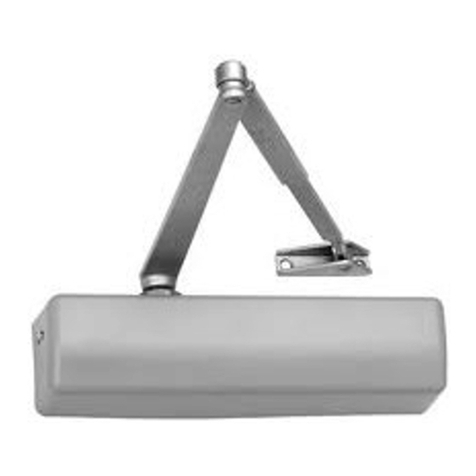
Assa Abloy
Assa Abloy Corbin Russwin DC6200 Series installation instructions

Assa Abloy
Assa Abloy Norton 5630 Series Installation and instruction manual
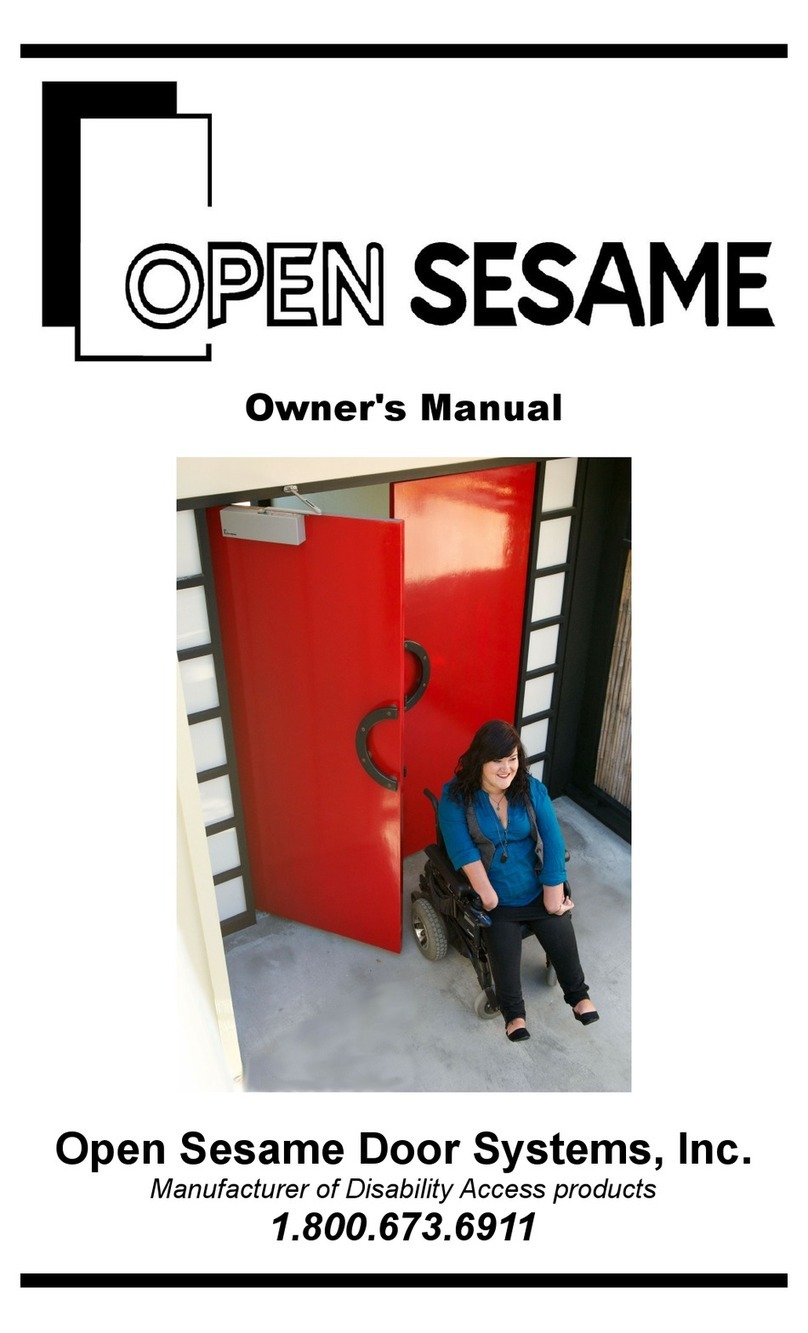
Open Sesame Door Systems
Open Sesame Door Systems 133 owner's manual

Assa Abloy
Assa Abloy Norton 1600 quick start guide

WebDoor
WebDoor CADET PRO Installation and instruction manual
